When the temperature on the field was 103°F for the first pitch of the “Fall Classic” last month, it seemed yet another sign that something was amiss with the planet’s thermostat. Granted, Game 1 on Oct. 24 was played in Los Angeles, but still…
This month, nearly 3,000 miles east in Boston, our industry will be focused on that changing thermostat and trading ideas on sustainable adjustments that benefit both users and the environment. Some 20,000 of us are expected at the 16th annual Greenbuild International Expo and Conference to brainstorm, share best practices, and showcase new products that building owners, design-builders, and operations and maintenance engineers are now openly embracing. Long gone are the tree-hugging stereotypes that once relegated the green movement to the fringes. Sincere or not, everyone seems to care now.
Why? Well, today, manufacturers and customers both see ‘green’ in the savings that increased efficiency, improved sustainability and ‘smarter’ equipment can yield. As Daikin Applied Americas CEO Mike Schwartz said last month at his firm’s customer conference in San Antonio, “We know the move to ‘net zero’ is real, regardless of recent efforts in Washington to slow down the momentum.”
Indeed, as Boston’s own malaprop comic Norm Crosby might say, “That horse has sailed.”
Today, the question has moved beyond threshold energy issues like lighting and temperature controls to address the broader health and productivity of building occupants.
That is the focus of the International WELL Building Institute (IWBI), which was started in 2013 as “a public benefit corporation” dedicated to promoting “health and wellness in buildings and communities everywhere.” Toward that end, it administers the WELL Building Standard, a new certification for indoor air quality, supported by the U.S. Green Building Council (USGBC), which runs Greenbuild. USGBC co-founder Rick Fedrizzi left that group last year to become IWBI’s chairman and CEO. He is no stranger to HVAC issues, having spent more than 25 years as an environmental marketing officer at UTC’s Carrier Corp.
In 2015, Fedrizzi authored the book, Greenthink: How Profit Can Save the Planet. In this odd era of technological enlightenment pitted against emboldened self-interest, it seems more than a bit ironic that it may end up being the profit motive, itself, that saves the day.
But read our November issue to see how owners like Baylor University in Texas, ArcBest in Arkansas, and Deloitte in Amsterdam are harvesting more ‘green’ by being more green.
At the end of the day, it all comes down to that bottom line and the long-term decision-making that benefits it most. What hard-nosed numbers-cruncher would have guessed that one day, it would all be underlined in green?










